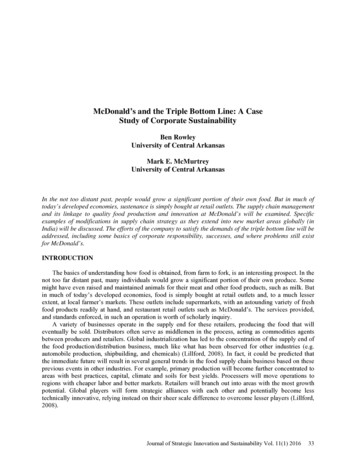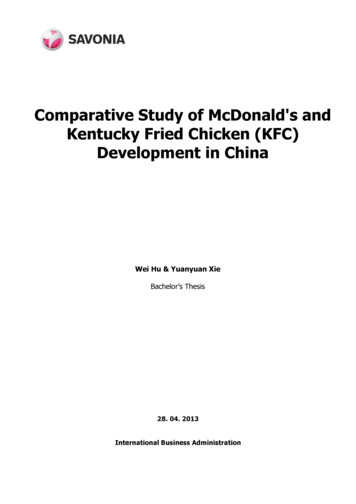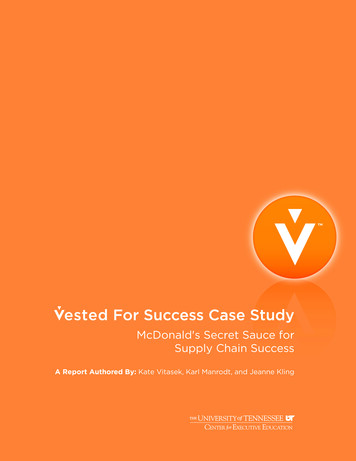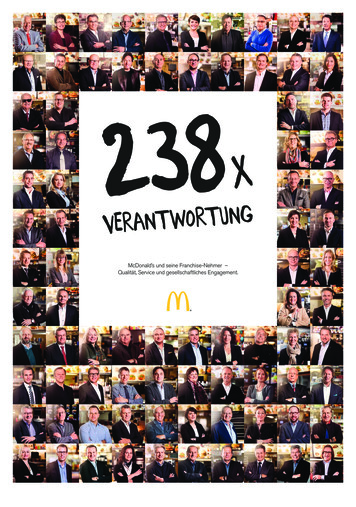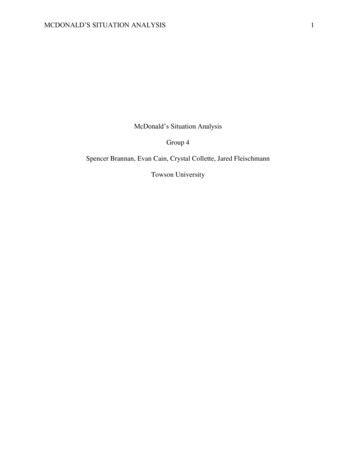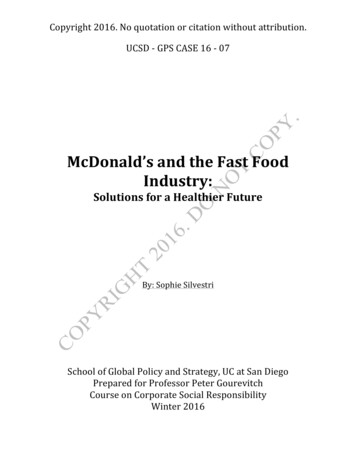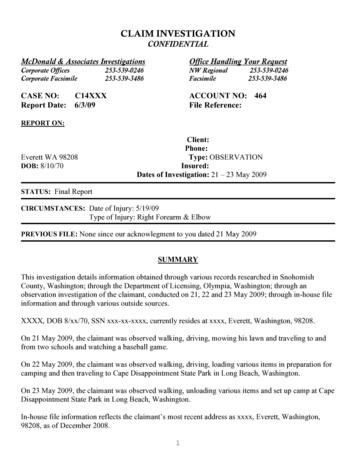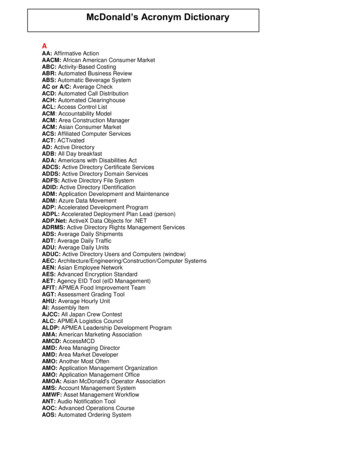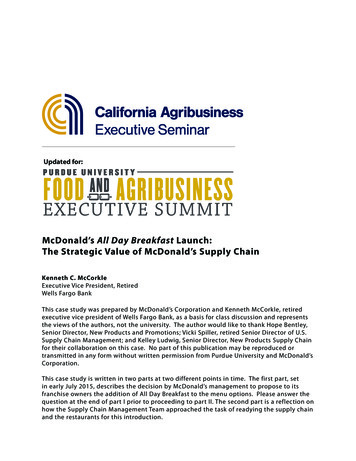
Transcription
Updated for:McDonald’s All Day Breakfast Launch:The Strategic Value of McDonald’s Supply ChainKenneth C. McCorkleExecutive Vice President, RetiredWells Fargo BankThis case study was prepared by McDonald’s Corporation and Kenneth McCorkle, retiredexecutive vice president of Wells Fargo Bank, as a basis for class discussion and representsthe views of the authors, not the university. The author would like to thank Hope Bentley,Senior Director, New Products and Promotions; Vicki Spiller, retired Senior Director of U.S.Supply Chain Management; and Kelley Ludwig, Senior Director, New Products Supply Chainfor their collaboration on this case. No part of this publication may be reproduced ortransmitted in any form without written permission from Purdue University and McDonald’sCorporation.This case study is written in two parts at two different points in time. The first part, setin early July 2015, describes the decision by McDonald’s management to propose to itsfranchise owners the addition of All Day Breakfast to the menu options. Please answer thequestion at the end of part I prior to proceeding to part II. The second part is a reflection onhow the Supply Chain Management Team approached the task of readying the supply chainand the restaurants for this introduction.
2 McDonald’s All Day Breakfast Launch: The Strategic Value of McDonald’s Supply Chain 2017 Purdue Univerisity
Oakbrook, Illinois. When Steve Easterbrook assumed control as CEO of McDonald’s Corporationin January 2015, it was assumed by insiders and outsiders alike that things were about to change.Since its founding by Ray Kroc in 1955, the company had experienced extraordinary periods ofgrowth and success – most recently from 2003 through 2013 - interrupted by brief lulls, and, insome cases, declines as it attempted to adjust to changes in its environment. Year 2014 was sucha lull period: revenues were down 2.4%, domestic same store sales were off 2.1%, net income wasdown nearly 15%, and return on beginning equity, while still impressive, was down from 37%in 2013 to 30% in 2014. Reflecting this performance, McDonald’s stock price, by mid-December2014 was off 16% from its peak value achieved the previous year. One analyst, at the time,described the company as “being on the wrong side of history” as younger consumers wereopting for healthier food and new, upscale quick service restaurant (QSR) chains. Shake Shack, 5Guys, and Chick-fil-A were carving out niches in an already crowded, mature QSR space.Furthermore, while the chain had previously faced competition within its own sector —theQSR industry— there were now multiple new, creative, rapidly growing food and food deliverychannels. Traditional grocery chains were offering multiple choices in both stage of preparation(fresh produce and groceries to fully prepared meals) and convenience in distribution from(restaurant pick up, online ordering, and home delivery). Online retailer Amazon was offeringlarge selections of both non-perishable and fresh food products with rapid delivery options. InSeptember 2015, Google announced it would partner with Whole Foods and Costco to deliverfresh food and groceries to several US test markets. The online behemoth already offered nonperishable groceries via partnerships with Target, Costco, and Fairway Market. Other companiessuch as fast growing upstarts Blue Apron and HelloFresh were offering attractively priced, weeklyhome delivery of gourmet kits: all ingredients and recipes to prepare fresh, nutritious upscalemeals in-home. Each of these new food channel choices represented a change in the industrylandscape, creating additional competition for consumers’ meal dollars. McDonald’s now facedthe classic “threat of substitutes” from Michael Porter’s Five Forces model, not just threatof competitors.Early in his tenure, Mr. Easterbrook described McDonald’s as a “modern progressive burgercompany” that would “be more progressive around our social purpose in order to deepen ourrelationships with communities on the issues that matter to them.” The changes this descriptionwould require in his first year were large. Importantly, this message signaled that McDonald’srecognized the critical importance of listening to consumers and responding to their needs. 2017 Purdue UniversityMcDonald’s All Day Breakfast Launch: The Strategic Value of McDonald’s Supply Chain 3
The rapid spread of mobile technology and social media created more complexity for any largecorporation seeking to control its narrative. McDonald’s needed to “join the online conversation.”One group about to feel the impact of Mr. Easterbrook’s vision was McDonald’s US Supply ChainManagement Team. Not only had he announced that by 2017, its U.S. restaurants would onlyuse chickens that are “raised without antibiotics important in human medicine,” he was alsoconsidering a bold new initiative dubbed All Day Breakfast. This initiative held the potential toexpand the Company’s consumer base from its historical roots of children and young families toa broad section of the population currently lost to competitors and alternate channels.A New Perspective on Competitive AdvantageThe nature of competitive advantage in business is changing in response to powerful forcesin the business environment. Historically, companies have relied on product attributes, brandidentity, proprietary technologies, trade secrets, patents and other intellectual propertysupported by advertising and promotion to create market niches. These niches wererelatively defensible as long as information transfer was slow, communication was limited,patent and trademark laws were effectively enforced, and companies could control themessage delivered to consumers.Today, many companies are finding the underpinnings of the competitive landscape to beevolving. Traditional competitive advantages are proving to be transitory: less reliable, lesssustainable moats protecting market niches. In their place, relationship-based and humancapital-based capabilities that enable companies to quickly and decisively exploit short-livedopportunities are creating long-lasting advantages.Forces contributing to this changing business environment include:Technological Innovation: The impact of technology on competitive advantage is multifaceted: Technology is allowing companies to offer consumers products higher in quality, safer,more convenient (in terms of preparation, packaging, and delivery), andlower in price. All of these facets suggest greater opportunities for product andservice differentiation.4 McDonald’s All Day Breakfast Launch: The Strategic Value of McDonald’s Supply Chain 2017 Purdue Univerisity
Technology is enabling food marketers to more reliably and more economically deliverthese differentiated product attributes to the consumer. Employing today’s technology,food marketers can more effectively predict demand and can more efficiently coordinatewith suppliers to ensure an adequate supply of products are delivered on time withoutincurring the cost of stocking excessive inventories. Virtually free communication and instantaneous information flow is facilitating morerapid imitation of product features and product offerings, shortening the lifespan anddegrading the value of traditional product attribute-based competitive advantages. Technology is facilitating the rise of new competition in many industries, as Uber,Amazon, Airbnb, Facebook, and Alibaba have demonstrated. Each of these companies isa new business model firmly based on information/communication technology that hasdisrupted traditional competitive advantages. The rise of social media has had a mixed effect. On one hand, social media is creatingopportunities for companies to receive rapid, unfettered consumer and public opinions,concerns, and desires. By “joining the online conversation,” and listening to stakeholders,companies can gain insights and respond more quickly and appropriately to theirdemands. On the other hand, social media is empowering consumers and activistgroups to provide feedback, share opinions, and organize to effect changes in companybehavior. Consumer dissatisfaction can no longer be readily isolated. Widespread distrustof institutions and traditional media have shifted how companies try to earn consumers’trust. For all of these reasons, the ability of companies to control the narrative is declining.Today, businesses must vie for favorable public reviews without appearing to try too hardor appearing inauthentic.Globalization: Similarly, globalization is multi-dimensional in its impact on competitiveadvantage. Global sourcing and marketing of food products increase the array and decreasethe seasonality of products enjoyed by today’s consumers. Globalization dramaticallyincreases the complexity associated with creating and managing supply chains to provideconsumers a consistent experience - a particularly important aspect of maintaining brandstrength. Laws protecting intellectual property rights are not universally accepted or globallyenforced. Companies that operate globally face significant risks in destabilized and emerging 2017 Purdue UniversityMcDonald’s All Day Breakfast Launch: The Strategic Value of McDonald’s Supply Chain 5
markets, which often make up a disproportionate portion of their growth. Companiesprocuring globally must also address consumer concerns regarding working and tradeconditions within the source countries.Changes in Consumer Interests and Behavior: Consumer needs and concerns continueto evolve, deepen, diversify, and segment. Where once product array and price wereof paramount importance, now quality, convenience, nutrition, and safety have beenelevated on the priority list. Today, consumers are demanding much more from thefood they consume, including how and where foods are available, and how they areproduced, processed, and distributed. A growing number of consumers are focusing onsocial, environmental, and animal welfare issues that, heretofore, were entrusted largelyto the discretion of the producer. These “credence attributes” often influence consumers’perceptions of taste and quality. Increasingly, consumers not only “eat with their eyes” but alsowith their conscience.Multiple food categories are experiencing a decline in brand loyalty as sectors of thepopulation seek greater variety in their consumption experience. Many companies (e.g.breweries, coffee houses) are exploiting this consumer trend by introducing and promotingnew, seasonal or “craft” offerings to generate consumer excitement.Changes in Standards of Acceptability: As the food industry has responded to thesedivergent consumer demands, standards of acceptability have risen. A growing proportionof today’s consumers demands near perfection in terms of food safety, food quality, foodavailability (no stock outs), and quality of the dining experience. These standards ofacceptability are increasingly extending into the social, environmental, and animal welfarerealms as well.As a result of these forces, today’s lasting competitive advantages are shifting away fromproduct attributes toward performance capabilities: strong, responsive, difficult-to-replicate,relationship-based advantages capable of exploiting temporary opportunities by executingquickly, decisively, and near perfectly.6 McDonald’s All Day Breakfast Launch: The Strategic Value of McDonald’s Supply Chain 2017 Purdue Univerisity
The Case for All Day BreakfastMcDonald’s Corporation consists largely of franchised stores: 36,899 in 120 countries. In2016, 85% of the stores were franchisee-owned, while 15% were owned by McDonald’s.1Under the franchising agreement, McDonald’s owns (or secures the long term lease for) theland and building. The franchisee provides a percentage of the initial capital required viainvestment in equipment, signs, seating and décor and through reinvesting in the businessover time. Company revenues consist of sales from Company-operated stores (63% of 2014revenue), franchise rent and fees (23% of 2014 revenue), and franchise royalties (12% of 2014revenue). Franchise rent and fees consist of an initial fee plus rent for the land and buildingowned by McDonald’s. Franchise royalties are a percentage of sales paid by the franchisee toMcDonald’s. Thus, the Corporation’s success is dependent on the profitability at the individualstore level.The economics of individual stores can be characterized as high fixed cost, modest variablecost businesses with strong gross margins. The high fixed costs include the franchise fee, rentfor the land and building, labor and benefits, energy, property taxes, business licenses andfees, and debt service. Variable costs consist of food raw materials, operating supplies, oftenincreasing labor costs, and royalties. Given this cost structure, volume throughput (numberof patrons per day) is a key success factor. Any initiative that expands the daily number ofpatrons purchasing high margin products improves the economics of the franchisee andrevenue to McDonald’s Corporation.In evaluating the All Day Breakfast (ADB) proposal, management identified a key trend thathelped drive decisions on its earlier successful initiatives and campaigns. The demographicsof the world population in general, and the U.S. population in particular, are changing. Theaverage age is rising while the number of young consumers (an historical McDonald’s targetmarket) is not growing as fast as the number of customers “graduating” from their McDonald’syears. The company had targeted and positioned itself to serve this younger market in itsproduct line, advertising, promotional activities, restaurant layout, and even its spokesperson,Ronald McDonald. As its customers aged and “graduated,” the company needed tocontinuously develop a new base of young customers just to stay even. Developing newcustomers is always more expensive than retaining existing customers. 2017 Purdue UniversityMcDonald’s All Day Breakfast Launch: The Strategic Value of McDonald’s Supply Chain 7
As an alternative to losing these once loyal customers, the company could reach out to itsexisting or previous customers by making its product offerings and dining experience morerelevant to the young adult. To reach these customers in transition, McDonald’s needed tostay in touch with what young adult consumers wanted: a great meal, at a great price, servedquickly every day. They needed to create deeper customer relationships and the ability todesign irreplaceable experiences to create longer-lived advantages.This thought process provided impetus to introduce Premium Roast coffee in 2006,followed by iced coffee and tea, then specialty coffee drinks including lattes, mochas andseasonal flavors. In 2010, the company expanded the menu choices by introducing twofruit smoothie products: Wild Berry Smoothie and Strawberry Banana Smoothie. In 2011,Fruit and Maple Oatmeal was added. These new products were positioned to appeal to abroader demographic profile and new consumer preferences, thus attracting more patronsto McDonald’s restaurants. They provided the company new items to advertise and promotethat were more in line with consumer preferences, a key to keeping the restaurant chain freshand relevant. These products provided value by addressing current consumer concerns for abalanced diet and calorie management.All Day Breakfast was a logical extension of expanding consumer choice to drive additionalpatron throughput. The company already offered most of the All Day Breakfast product linein the breakfast menu. Despite their restricted hours from opening to 10:30 am, breakfastitems represented 25% of restaurant sales. The breakfast menu items were already favored bynutritionally-conscious consumers. Shifts in demographics and the economy had led to moreAmericans being engaged in shift work versus traditional 9-5 employment. Other food outletswere successfully serving breakfast to consumers whose breakfast needs extended beyondthe traditional morning hours.McDonald’s early adoption of social media to communicate with its stakeholders providedsupport for extending breakfast items beyond 10:30 am. Social media indicated thatbreakfast, offered beyond the traditional morning hours, was popular among consumers.With its limited hours for breakfast, McDonald’s restaurants were losing these potentialsales. If breakfast were offered 24 hours a day, the Company could potentially expand itscustomer base from its historical roots of children and young families to a broader sectionof the population.8 McDonald’s All Day Breakfast Launch: The Strategic Value of McDonald’s Supply Chain 2017 Purdue Univerisity
Finally, industry statistics supported extending the hours breakfast items were offered.The domestic fast food breakfast market was over 32 billion in 2013. From 2007 to2012, breakfast sales at fast-food restaurants rose by an average of 4.8 percent per year.Concurrently, lunch and dinner at those same restaurants have been flat or declining.Testing the MarketOn March 29, 2015, McDonald’s announced it would test market All Day Breakfast in its 94 SanDiego-area restaurants. The test, scheduled for launch on April 19, 2015, would be supportedwith marketing tactics which included promotional coupons for breakfast items mailed ande-mailed to area residents. The most popular breakfast items – the Egg McMuffin, breakfastburrito and hot cakes platforms – would be available all day, but McGriddles and biscuitsandwiches would continue to be offered only from opening to 10:30 am.While there was general excitement over the new initiative, there were also some concernsamong franchise owners and McDonald’s restaurant managers. During the busy lunch hours,breakfast items would compete with burgers and chicken for limited grill space. Customerservice times – a critical metric in the QSR industry — could be effected. Operationalcomplexity would increase, particularly during the most critical hours. Further, it wasanticipated that some customers would be tempted to trade down from higher pricedburgers to lower priced breakfast items in their purchases. Gearing up for such a significantchange would require considerable planning and coordination with suppliers of both foodand restaurant equipment.McDonald’s would observe restaurant operations in these test stores and survey San Diegocustomers on their purchasing experiences over the following several weeks. This informationwould provide important data for how to proceed.By mid-May 2015, sales data from the test market were indicating solid same-store salesgrowth attributable to All Day Breakfast. The data also confirmed that equipment constraints,especially grill space, were creating operational bottlenecks. If ADB were to be expandedregionally or nationally, substantial equipment purchases would be required by franchisees.Much of this equipment would require long lead times from order to delivery dates. 2017 Purdue UniversityMcDonald’s All Day Breakfast Launch: The Strategic Value of McDonald’s Supply Chain 9
In July 2015, recognizing the potential favorable impact on its fourth quarter and ongoingfinancial performance, McDonald’s company and owner-operator leadership endorsed thenational launch of All Day Breakfast. The final launch decision was contingent on furtherfranchisee approval (votes by co-ops of owner-operators) by the end of August. They set anaggressive timeline for its launch.McDonald’s US Supply Chain ManagementMcDonald’s U.S. Supply Chain Management (SCM) is a unique, dis-integrated system. Inserving nearly 27 million U.S. customers each day, the company does not produce, warehouse,or transport any of its equipment, food, packaging or other supplies; all of its supply chainis outsourced. Suppliers are independently owned and operated to keep the relationshipat arm’s length and to allow each company the ability to focus on and leverage its area ofexpertise. The supply chain is built on a balance of demonstrated results and long-termrelationships, with suppliers that are flexible, responsive, and willing to invest for the longterm benefit of the relationship. SCM is responsible for managing these relationships and theperformance of the supply chain system.The decision in July 2015 to launch All Day Breakfast (ADB) presented SCM and the supplychain partners a challenging timeline to plan and execute. The supply chain consists ofdozens of independent strategic and non-strategic suppliers, as well as their secondarysuppliers. It is no minor feat to prepare the supply chain to act in concert in servicing theneeds of 13,700 mostly independently-owned restaurants spanning the country to servemore customers a broader, nationally-promoted menu. Initial and replenishment quantitiesof food items would need to be forecast from very limited data. The supply chain must benotified and prepared to produce, ship and handle the additional volume generated bythe ADB initiative. For some commodities (notably eggs and hash browns), these increasedvolumes could impact entire industry segments. Logistics must be arranged to supportthe transport from supplier to hub or distribution center, from hub to distribution centerwhere applicable, and from distribution center to restaurant. Restaurant equipment mustbe ordered, manufactured, shipped, delivered, and installed. Each restaurant must beadequately stocked with initial food and packaging supplies. Replenishment quantities must10 McDonald’s All Day Breakfast Launch: The Strategic Value of McDonald’s Supply Chain 2017 Purdue Univerisity
be properly staged in distribution centers and in some cases, redistribution hubs. Sales andinventories must be monitored closely to be sure adequate, but not excessive, replenishmentinventories are maintained. The test market experience for ADB would be used to generatethe national forecast, but the number of markets and the restaurant count involved in the testwere both much lower than typical for forecasting a national launch. Therefore, each link inthe supply chain must be prepared for an inaccurate demand forecast – too high or too low– and be prepared to immediately adjust. This “certainty about forecast uncertainty” wouldbe especially challenging for fresh agricultural products such as the fresh-cracked eggs in theEgg McMuffin product line, especially in the wake of the spring-summer 2015 outbreak ofavian influenza which had impacted McDonald’s suppliers.Discussion QuestionIt is July 2015. You are the senior manager of McDonald’s Supply Chain Management Team.You have been in top level management discussions regarding the possible implementationof the All Day Breakfast for three months, monitoring the limited test market data. You havejust been notified that the initiative, assuming approval by the franchise operators (results oftheir vote will be known by September 1) is a go: ADB will be launched nationally at 13,700restaurants the first week of October. What are your top priorities? 2017 Purdue UniversityMcDonald’s All Day Breakfast Launch: The Strategic Value of McDonald’s Supply Chain 11
Part 2Early in July 2015, McDonald’s management announced its decision to launch All DayBreakfast nationally. Based on the successful test market data and the potential positivefinancial impact of ADB, the launch date of October 1 was announced. This aggressive launchdate would create a number of challenges for the Supply Chain Management Team.The ChallengesThe challenges to a flawless ADB launch were considerable:Uncertain Demand: The speed to market imperative of the ADB launch necessitated that thesupply chain be prepared for any volume increase. A successful ADB launch would increasedemand for McDonald’s breakfast food items. But, by how much? Any significant increasecould run up against supplier capacity constraints for some food items, constraints that wouldneed to be addressed in advance.ADB had been tested in local markets earlier in the year to gauge its popularity. However,results from these test markets were not necessarily reliable indicators of actual demand ona national scale. If forecasts proved too optimistic, McDonald’s suppliers and franchiseescould be investing too heavily in inventories and the logistics to support this inventory. If thedemand forecasts significantly under-estimated demand, the company risked stocking out ofproduct and disappointing customers, an even greater misstep which would surely attract theattention of competitors, social media, and Wall Street.Vulnerable Egg Supply: Highly pathogenic avian influenza (HPAI) H5 infections had beenreported in U.S. domestic poultry in 15 states from December 2014 through June 2015.Infections within egg laying flocks were concentrated in the Midwestern states of Iowa,Nebraska, Minnesota, Wisconsin, and South Dakota. Nearly 42 million laying hens in thesefour states – 38% of the region’s and 14% of the nation’s laying flock - had been wiped out.The National Center for Disease Control was warning that H5 outbreaks in birds in the UnitedStates could recur in the fall and winter 2015. This highly contagious poultry disease generally12 McDonald’s All Day Breakfast Launch: The Strategic Value of McDonald’s Supply Chain 2017 Purdue Univerisity
requires quarantining production facilities and destroying infected flocks, therefore posingconsiderable risk to those dependent on a reliable egg supply.As a result of the avian influenza outbreak, McDonald’s egg supply chain had lost 46% of itssuppliers’ dedicated laying hens. Available shell egg capacity for McDonald’s as of July 2015was 83,000 cases per week. Its projected needs could be as high as 145,000 cases/week. Eggsupplies nationwide were tight after 7 months of flock destruction and future supplies wereuncertain. McDonald’s animal welfare standards required additional steps and oversightbefore qualifying new producers, and meant that not all producer facilities could qualify,further adding to the complexity the supply chain faced before and during the launch of ADB.Constrained Hash Brown Capacity: Global manufacturing capacity for McDonald’sspecification of hash brown patties is limited. Three North American potato processors supply100% of McDonald’s U.S. hash browns and a significant percentage of its global hash brownrequirements. The anticipated increase in hash brown demand resulting from ADB wouldpush the limits of the approved suppliers’ production capacity. Without proper coordination,it could also disrupt promotional activities beyond McDonald’s U.S. market. In addition, oilquality plays a very important role in hash brown quality, and McDonald’s and its suppliersused a unique zero-TFA oil blend.Original English Muffin Capacity and Transition: McDonald’s English muffin sourcingposed multiple challenges. First, production capacity among its suppliers was tight and notevenly distributed across regions. If sales reached the high-end forecast, McDonald’s wouldnot have adequate supplier capacity in the right place, so regional shortages were probable.Distribution was not homogeneous, as some fresh and frozen muffins were distributed viadistribution centers and/or re-distribution hubs, while some bakers were close enough totheir end users to distribute fresh using direct-store-delivery. This multi-modal, multi-levelsupply chain was not yet on-boarded to McDonald’s supply chain integration platformwhich provided suppliers and McDonald’s one shared view of demand. Lastly, the Companydecided, nearly concurrent with the ADB decision, to transition from a newer formulacontaining a unique finely milled whole grain flour, back to the 100% unbleached flour in itsEnglish muffin recipe. To avoid confusion, it was important that the muffin transition in therestaurants be completed prior to the ADB launch. 2017 Purdue UniversityMcDonald’s All Day Breakfast Launch: The Strategic Value of McDonald’s Supply Chain 13
Margarine to Butter Transition: In January 2015, McDonald’s formalized its Food Vision andProduct Road Map. This document drove the decision to convert from an easy-to-use liquidmargarine to real butter. This decision would have significant consequences to suppliers andrestaurant operations. Margarine and margarine suppliers would be phased out; butter would bephased in, butter suppliers added, and restaurant crews re-trained. ADB would greatly increasebutter needs. In February 2015, just ten months prior to the ADB launch, McDonald’s had onlyone active butter supplier.Carrier Capacity Constraints: The transportation market was chronically very tight: truckingcapacity was in high demand and short supply. Two transportation issues could potentially resultin unacceptable inventory shortages: weather disruptions or sales exceeding forecast. If sufficientcarrier capacity were not pre-negotiated, the excess loads would necessarily be tendered throughthe brokerage channel, an unreliable and costly alternative.Equipment and Timing: Well before the launch decision was made, the equipment team faced adilemma: how to meet the equipment requirements of each restaurant by the launch date when:(a) the launch was not yet a certainty, and (b) the needs of each restaurant were not known. Thedecision to launch – requiring support from both corporate senior leadership and franchisees —would not be made until it was too late to meet the equipment requirements. The equipmentteam could not wait until decisions were finalized to begin its preparations, but makingcommitments to suppliers absent a firm decision exposed all parties to considerable risk.The dimensions of its dilemma were significant:Manufacturing constraints: The proposed ADB national launch, if approved, would belaunched almost concurrently with the Original English Muffin initiative. Together, these twoinitiatives would require additional toasters, egg cookers, and other equipment at each of the13,700 domestic restaurants. Potentially, a res
Aug 01, 2019 · McDonald’s Corporation consists largely of franchised stores: 36,899 in 120 countries. In 2016, 85% of the stores were franchisee-owned, while 15% were owned by McDonald’s.1 Under the franchising agreement, McDonald’s owns (o

